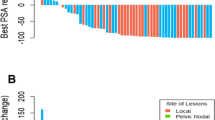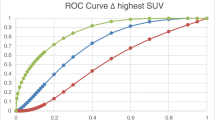Abstract
Purpose
To compare the Response Evaluation Criteria in Solid Tumors (RECIST) 1.1, the adapted Prostate Cancer Working Group Criteria 3 (aPCWG3), the adapted Positron Emission Tomography Response Criteria in Solid Tumors (aPERCIST), the PSMA PET Progression (PPP), and the Response Evaluation Criteria In PSMA-Imaging (RECIP) 1.0 for response evaluation using prostate-specific membrane antigen (PSMA)-PET/CT in men with metastatic castration-resistant prostate cancer (mCRPC) treated with 177Lu-PSMA radioligand therapy.
Methods
A total of 124 patients were included in this multicenter retrospective study. All patients received 177Lu-PSMA and underwent PSMA-PET/CT scans at baseline (bPET) and at 12 weeks (iPET). Imaging responses according to RECIST 1.1, aPCWG3, aPERCIST, PPP, and RECIP 1.0 were interpreted by consensus among three blinded readers. Changes in total tumor burden were obtained using the semi-automatic qPSMA software. The response according to each criterion was classified to progressive disease (PD) vs no-PD. Primary outcome measure was the prognostic value (by Cox regression analysis) for overall survival (OS). Secondary outcome measure was the inter-reader reliability (by Cohen’s κ coefficient).
Results
A total of 43 (35%) of patients had non-measurable disease according to RECIST 1.1. Sixteen (13%), 66 (52%), 72 (58%), 69 (56%), and 39 (32%) of 124 patients had PD according to RECIST 1.1, aPCWG3, aPERCIST, PPP, and RECIP, respectively. PD vs no-PD had significantly higher risk of death according to aPCWG3 (HR = 2.37; 95%CI, 1.62–3.48; p < 0.001), aPERCIST (HR = 2.48; 95%CI, 1.68–3.66; p < 0.001), PPP (HR = 2.72; 95%CI, 1.85–4.01; p < 0.001), RECIP 1.0 (HR = 4.33; 95%CI, 2.80–6.70; p < 0.001), but not according to RECIST 1.1 (HR = 1.29; 95%CI, 0.73–2.27; p = 0.38). The κ index of RECIST 1.1, aPCWG3, aPERCIST 1.0, PPP, and RECIP 1.0 for identifying PD vs no-PD were 0.50 (95%CI, 0.32–0.76), 0.72 (95%CI, 0.63–0.82), 0.68 (95%CI, 0.63–0.73), 0.73 (95%CI, 0.63–0.83), and 0.83 (95%CI, 0.77–0.88), respectively.
Conclusion
PSMA-PET-specific criteria for early response evaluation in men with mCRPC treated with 177Lu-PSMA achieved higher prognostic values and inter-reader reliabilities in comparison to conventional CT assessment or to criteria adapted to PSMA-PET from other imaging modalities. RECIP 1.0 identified the fewest patients with PD and achieved the highest risk of death for PD vs. no-PD, suggesting that other classification methods tend to overcall progression. Prospective validation of our findings on an independent patient cohort is warranted.



Similar content being viewed by others
References
Schwartz LH, Litiere S, de Vries E, Ford R, Gwyther S, Mandrekar S, et al. RECIST 1.1-Update and clarification: from the RECIST committee. Eur J Cancer. 2016;62:132–7. https://doi.org/10.1016/j.ejca.2016.03.081.
Wahl RL, Jacene H, Kasamon Y, Lodge MA. From RECIST to PERCIST: evolving considerations for PET response criteria in solid tumors. J Nucl Med. 2009;50 Suppl 1:122s-s150. https://doi.org/10.2967/jnumed.108.057307.
Scher HI, Morris MJ, Stadler WM, Higano C, Basch E, Fizazi K, et al. Trial design and objectives for castration-resistant prostate cancer: updated recommendations from the Prostate Cancer Clinical Trials Working Group 3. J Clin Oncol. 2016;34:1402–18. https://doi.org/10.1200/jco.2015.64.2702.
U.S. Food and Drug Administration website. FDA approves second PSMA-targeted PET imaging drug for men with prostate cancer. 2021. https://www.fda.gov/drugs/news-events-human-drugs/fda-approves-second-psma-targeted-petimaging-drug-men-prostate-cancer. Accessed 21 March 2022.
Hofman MS, Lawrentschuk N, Francis RJ, Tang C, Vela I, Thomas P, et al. Prostate-specific membrane antigen PET-CT in patients with high-risk prostate cancer before curative-intent surgery or radiotherapy (proPSMA): a prospective, randomised, multicentre study. Lancet. 2020;395:1208–16. https://doi.org/10.1016/s0140-6736(20)30314-7.
Fanti S, Hadaschik B, Herrmann K. Proposal of systemic therapy response assessment criteria in time of PSMA PET/CT imaging: PSMA PET progression (PPP). J Nucl Med. 2019. https://doi.org/10.2967/jnumed.119.233817.
Gafita A, Rauscher I, Weber M, Hadaschik B, Wang H, Armstrong WR, et al. Novel framework for treatment response evaluation using PSMA-PET/CT in patients with metastatic castration-resistant prostate cancer (RECIP 1.0): an international multicenter study. J Nucl Med. 2022:jnumed.121.263072. https://doi.org/10.2967/jnumed.121.263072.
Sartor O, de Bono J, Chi KN, Fizazi K, Herrmann K, Rahbar K, et al. Lutetium-177–PSMA-617 for metastatic castration-resistant prostate cancer. N Eng J Med. 2021:1091–103. https://doi.org/10.1056/NEJMoa2107322.
Hofman MS, Emmett L, Sandhu S, Iravani A, Joshua AM, Goh JC, et al. [177Lu]Lu-PSMA-617 versus cabazitaxel in patients with metastatic castration-resistant prostate cancer (TheraP): a randomised, open-label, phase 2 trial. Lancet. 2021;397:797–804. https://doi.org/10.1016/S0140-6736(21)00237-3.
Gafita A, Calais J, Grogan TR, Hadaschik B, Wang H, Weber M, et al. Nomograms to predict outcomes after (177)Lu-PSMA therapy in men with metastatic castration-resistant prostate cancer: an international, multicentre, retrospective study. Lancet Oncol. 2021. https://doi.org/10.1016/s1470-2045(21)00274-6.
Wurzer A, Di Carlo D, Schmidt A, Beck R, Eiber M, Schwaiger M, et al. Radiohybrid ligands: a novel tracer concept exemplified by (18)F- or (68)Ga-labeled rhPSMA inhibitors. J Nucl Med. 2020;61:735–42. https://doi.org/10.2967/jnumed.119.234922.
Eder M, Neels O, Müller M, Bauder-Wüst U, Remde Y, Schäfer M, et al. Novel preclinical and radiopharmaceutical aspects of [68Ga]Ga-PSMA-HBED-CC: a new PET tracer for imaging of prostate cancer. Pharmaceuticals (Basel). 2014;7:779–96. https://doi.org/10.3390/ph7070779.
Ceci F, Oprea-Lager DE, Emmett L, Adam JA, Bomanji J, Czernin J, et al. E-PSMA: the EANM standardized reporting guidelines v1.0 for PSMA-PET. Eur J Nucl Med Mol Imaging. 2021;48:1626–38. https://doi.org/10.1007/s00259-021-05245-y.
Gafita A, Bieth M, Krönke M, Tetteh G, Navarro F, Wang H, et al. qPSMA: semiautomatic software for whole-body tumor burden assessment in prostate cancer using (68)Ga-PSMA11 PET/CT. J Nucl Med. 2019;60:1277–83. https://doi.org/10.2967/jnumed.118.224055.
Murthy V, Smith RL, Tao DH, Lawhn-Heath CA, Korenchan DE, Larson PEZ, et al. 68Ga-PSMA-11 PET/MRI: determining ideal acquisition times to reduce noise and increase image quality. EJNMMI Physics. 2020;7:54. https://doi.org/10.1186/s40658-020-00322-x.
Antolini L, Boracchi P, Biganzoli E. A time-dependent discrimination index for survival data. Stat Med. 2005;24:3927–44. https://doi.org/10.1002/sim.2427.
McHugh ML. Interrater reliability: the kappa statistic. Biochem Med. 2012;22:276–82.
Seifert R, Kessel K, Schlack K, Weckesser M, Kersting D, Seitzer KE, et al. Total tumor volume reduction and low PSMA expression in patients receiving Lu-PSMA therapy. Theranostics. 2021;11:8143–51. https://doi.org/10.7150/thno.60222.
Seitz AK, Rauscher I, Haller B, Kronke M, Luther S, Heck MM, et al. Preliminary results on response assessment using (68)Ga-HBED-CC-PSMA PET/CT in patients with metastatic prostate cancer undergoing docetaxel chemotherapy. Eur J Nucl Med Mol Imaging. 2018;45:602–12. https://doi.org/10.1007/s00259-017-3887-x.
Michalski K, Klein C, Brueggemann T, Meyer PT, Jilg CA, Ruf J. Assessing response to [(177)Lu]PSMA radioligand therapy using modified PSMA PET progression criteria. J Nucl Med. 2021. https://doi.org/10.2967/jnumed.120.260836.
Armstrong AJ, Saad F, Phung D, Dmuchowski C, Shore ND, Fizazi K, et al. Clinical outcomes and survival surrogacy studies of prostate-specific antigen declines following enzalutamide in men with metastatic castration-resistant prostate cancer previously treated with docetaxel. Cancer. 2017;123:2303–11. https://doi.org/10.1002/cncr.30587.
Calais J, Gafita A, Eiber MR, Armstrong WR, Gartmann J, Thin P, et al. Prospective phase 2 trial of PSMA-targeted molecular RadiothErapy with <sup>177</sup>Lu-PSMA-617 for metastatic Castration-reSISTant Prostate Cancer (RESIST-PC): efficacy results of the UCLA cohort. J Nucl Med. 2021:jnumed.121.261982. https://doi.org/10.2967/jnumed.121.261982.
Fendler WP, Eiber M, Beheshti M, Bomanji J, Ceci F, Cho S, et al. (68)Ga-PSMA PET/CT: joint EANM and SNMMI procedure guideline for prostate cancer imaging: version 1.0. Eur J Nucl Med Mol Imaging. 2017;44:1014–24. https://doi.org/10.1007/s00259-017-3670-z.
Dietlein M, Kobe C, Kuhnert G, Stockter S, Fisher T, Schomaecker K, et al. Comparison of [(18)F]DCFPyL and [(68)Ga]Ga-PSMA-HBED-CC for PSMA-PET imaging in patients with relapsed prostate cancer. Mol Imaging Bol. 2015;17:575–84. https://doi.org/10.1007/s11307-015-0866-0.
Hoberück S, Löck S, Borkowetz A, Sommer U, Winzer R, Zöphel K, et al. Intraindividual comparison of [(68) Ga]-Ga-PSMA-11 and [(18)F]-F-PSMA-1007 in prostate cancer patients: a retrospective single-center analysis. EJNMMI Res. 2021;11:109. https://doi.org/10.1186/s13550-021-00845-z.
Kroenke M, Mirzoyan L, Horn T, Peeken JC, Wurzer A, Wester HJ, et al. Matched-pair comparison of (68)Ga-PSMA-11 and (18)F-rhPSMA-7 PET/CT in patients with primary and biochemical recurrence of prostate cancer: frequency of non-tumor-related uptake and tumor positivity. J Nucl Med. 2021;62:1082–8. https://doi.org/10.2967/jnumed.120.251447.
Funding
The research leading to these results received funding from the Prostate Cancer Foundation (grant 21YOUN18).
Author information
Authors and Affiliations
Corresponding author
Ethics declarations
Ethical approval
All procedures performed in studies involving human participants were in accordance with the ethical standards of the institutional and/or national research committee and with the 1964 Helsinki declaration and its later amendments or comparable ethical standards. The retrospective analysis was approved by the Ethics Committee of each participating site (TUM 115/18S, UCLA IRB #20–000954, UKE 19–8570-BO) which waived the necessity for study specific consent.
Conflict of interest
ME reports fees from Blue Earth Diagnostics Ltd. (consultant, research funding), Novartis/AAA (consultant), Telix (consultant), Bayer (consultant, research funding), RayzeBio (consultant), Point Biopharma (consultant) and Janssen Pharmaceuticals (consultant, speakers bureau), Parexel (image review) and Bioclinica (image review) outside the submitted work and a patent application for rhPSMA. JCa reports prior consulting activities outside of the submitted work for Advanced Accelerator Applications, Blue Earth Diagnostics, Curium Pharma, GE Healthcare, IBA Radiopharma, Janssen Pharmaceuticals, POINT biopharma, Progenics Pharmaceuticals, Radiomedix, and Telix Pharmaceuticals. KH reports personal fees from Bayer, personal fees and other from Sofie Biosciences, personal fees from SIRTEX, non-financial support from ABX, personal fees from Adacap, personal fees from Curium, personal fees from Endocyte, grants and personal fees from BTG, personal fees from IPSEN, personal fees from Siemens Healthineers, personal fees from GE Healthcare, personal fees from Amgen, personal fees from Novartis, personal fees from ymabs, personal fees from Bain Capital, and personal fees from MPM Capital outside the submitted work. WPF reports fees from SOFIE Bioscience (research funding), Janssen (consultant, speakers bureau), Calyx (consultant), Bayer (consultant, speakers bureau, research funding), Parexel (image review), and AAA (speakers bureau) outside of the submitted work. WAW was on advisory boards and received compensation from Bayer, Blue Earth Diagnostics, Endocyte, ITM, RayzeBio, and Pentixapharm. He has received research support from BMS, Imaginab, Ipsen, and Piramal. No other potential conflict of interest relevant to this article was reported.
Additional information
Publisher's note
Springer Nature remains neutral with regard to jurisdictional claims in published maps and institutional affiliations.
This article is part of the Topical Collection on Oncology - Genitourinary.
Andrei Gafita and Isabel Rauscher are joint first authorship.
Manuel Weber and Matthias R. Benz are joint senior authorship.
Supplementary Information
Below is the link to the electronic supplementary material.
Rights and permissions
About this article
Cite this article
Gafita, A., Rauscher, I., Fendler, W.P. et al. Measuring response in metastatic castration-resistant prostate cancer using PSMA PET/CT: comparison of RECIST 1.1, aPCWG3, aPERCIST, PPP, and RECIP 1.0 criteria. Eur J Nucl Med Mol Imaging 49, 4271–4281 (2022). https://doi.org/10.1007/s00259-022-05882-x
Received:
Accepted:
Published:
Issue Date:
DOI: https://doi.org/10.1007/s00259-022-05882-x




